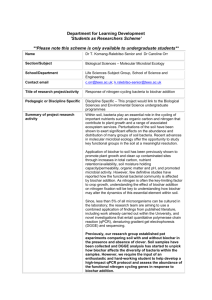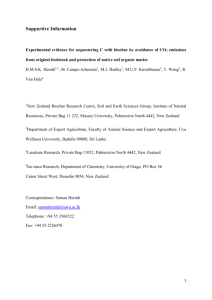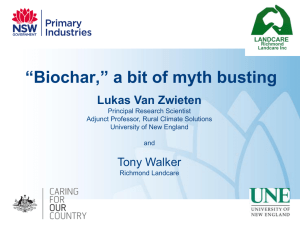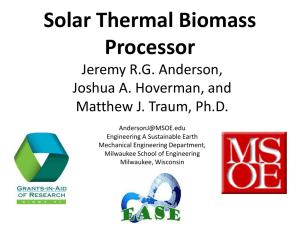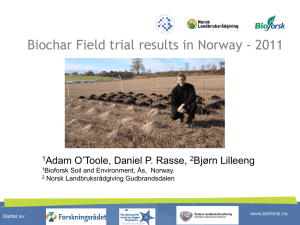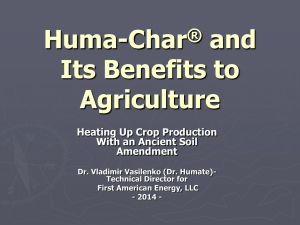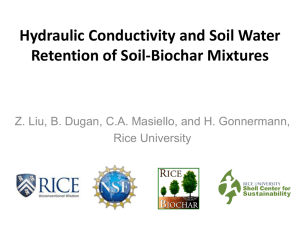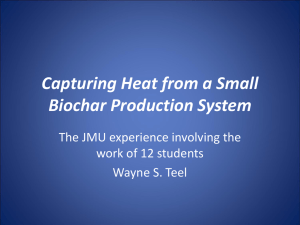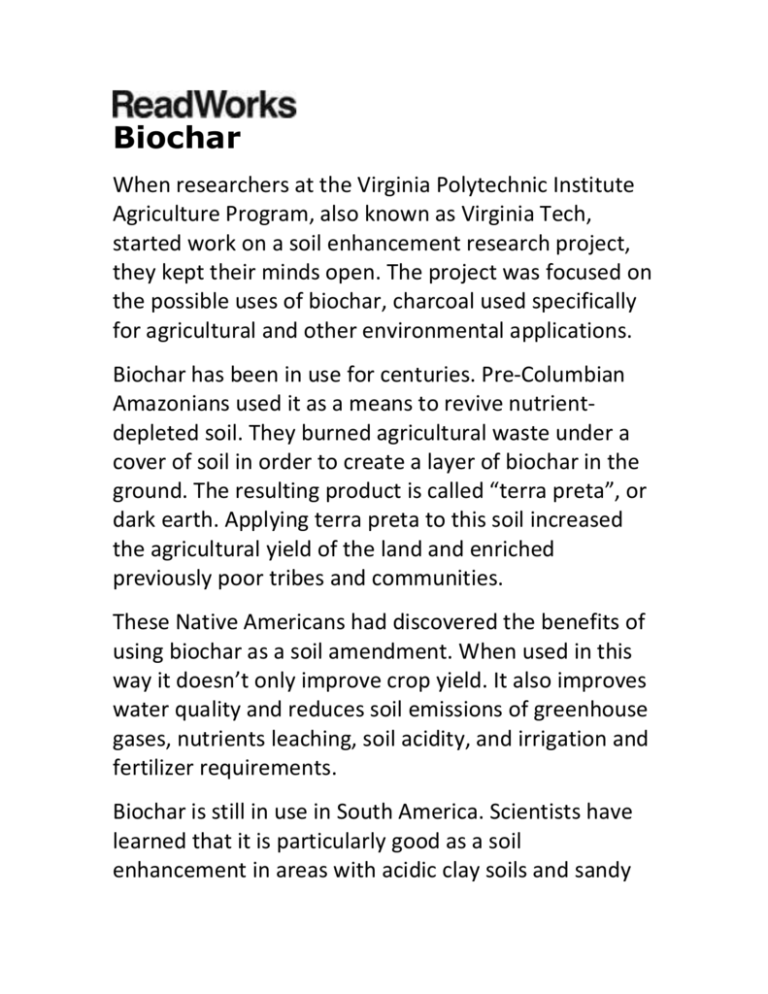
Biochar
When researchers at the Virginia Polytechnic Institute
Agriculture Program, also known as Virginia Tech,
started work on a soil enhancement research project,
they kept their minds open. The project was focused on
the possible uses of biochar, charcoal used specifically
for agricultural and other environmental applications.
Biochar has been in use for centuries. Pre‐Columbian
Amazonians used it as a means to revive nutrient‐
depleted soil. They burned agricultural waste under a
cover of soil in order to create a layer of biochar in the
ground. The resulting product is called “terra preta”, or
dark earth. Applying terra preta to this soil increased
the agricultural yield of the land and enriched
previously poor tribes and communities.
These Native Americans had discovered the benefits of
using biochar as a soil amendment. When used in this
way it doesn’t only improve crop yield. It also improves
water quality and reduces soil emissions of greenhouse
gases, nutrients leaching, soil acidity, and irrigation and
fertilizer requirements.
Biochar is still in use in South America. Scientists have
learned that it is particularly good as a soil
enhancement in areas with acidic clay soils and sandy
soils. Biochar increases the soil’s ability to attract and
retain water. As a result, nutrients, phosphorus and
agrochemicals are retained for the plant’s benefit.
Plants are therefore healthier and fertilizers leach less
into surface or groundwater. Biochar is a useful carbon
sequestration tool. The hope is that rural farmers in
Brazil will switch from traditional slash and burn
farming to slash and char.
Biochar
© 2013 ReadWorks®, Inc. All rights reserved.
Biochar
So what does an ancient agricultural technology have
to do with the scientists at Virginia Tech?
The researchers at Virginia Tech work in environmental
science. Many of them also live in central Appalachia.
Central Appalachia is mining country. For generations,
the area has been mined for coal. More recently,
mining companies have been using a technique called
mountaintop removal. This means they take layers of
rock and mineral off the top of the mountain in order
to get access to the coal seams inside. The removed
mountaintop, called overburden, is replaced on the
ridge and compacted to replicate the original mountain
shape. Energy and environmental industry officials call
these areas post‐mined land.
Post‐mining sites are difficult to reclaim. The resulting
soil is highly acidic and infertile. The post‐mined
compacted soil proves more difficult to seed. The soil
needs to be loose and open in order for seed to get into
the soil. In post‐mined land, the ground is too compact.
Post‐mining sites, therefore, typically look very
different from the surrounding area. These sites are
more likely to be home to invasive botanical species.
Residents and environmental activists complain the
landscape is ruined, that the mountain terrain is
scarred.
Even if no new permits for mountaintop removal mines
are issued, the problem of how to reclaim the post‐
mined sites remains. Researchers at Virginia Tech
decided to try using biochar to help reforest the post‐
mining site soil. They got permission to apply a layer of
biochar to a post‐mining site before it was reseeded
and replanted. What the team found was that the
biochar worked, but not as well as they had hoped. Soil
samples showed the biochar had improved the
chemistry of the soil. But not enough biochar had been
added to make a serious difference. Researchers
learned they would have to seriously up the amount of
biochar they applied to the site. The kind of biochar the
team used, however, was expensive. It cost about
$1,000 a ton. Ten tons per acre, the amount the
researchers applied, wasn’t enough biochar to make a
significant improvement to the soil conditions across
the site.
The research project had a practical constraint. The
team was looking for a solution to the problem of post‐
mining land. If the biochar was going to cost a small
fortune, it would not be feasible for local government
or nonprofit groups to use in such large amounts.
© 2013 ReadWorks®, Inc. All rights reserved.
Biochar
The team went back to the drawing board. They
redesigned the biochar tests by increasing the
concentration of biochar in specific locations. In other
words, the team created “planting cells” of biochar‐
enhanced soil on the post‐mining site. Within these
“cells” the soil recomposed itself quickly and well. The
team had created healthy soil in which saplings could
grow. Many trees die on post‐mining sites, so
improving the chances for individual trees to survive
was a good result.
The team would have rather seen the same results with
a small amount of biochar spread across the post‐
mining site. But getting some improvements, given the
financial constraint, was better than nothing.
Happily, researchers working with biochar learned that
its physical properties would make it ideal for working
with other environmental problems. They hypothesized
that the material would be useful in treating the
biosolids that come from municipal waste, in other
words, the sewage of urban areas. Urban waste is, in
many areas, dumped into fields outside the
municipality, creating zones that smell bad and can’t be
used for other purposes. The municipal waste is very
wet and the biochar is very dry. Researchers
hypothesized that biochar can be added to coat the
waste to create a product that can be spread as
fertilizer. In the process, the biochar reduces the smell
of the waste and helps reduce greenhouse gases. Early
studies show they are correct; biochar can be used in
this way.
© 2013 ReadWorks®, Inc. All rights reserved.
Name: Date:
1. What is biochar?
A a specific type of municipal waste
B an ancient
agricultural technique that was recently
discovered
C
charcoalthatisusedforagriculturalandotherenvironmen
talapplications
D a mining technique that removes
layers of rock and mineral from mountaintops
2. What does the author describe in the passage?
A past and present uses of biochar
B preColumbian Amazonian social customs
C
famousresearchprojectsatVirginiaTech
D protests
against mountaintop removal mining
3. Plants are healthier when seeded in soil that has
been treated with biochar. What evidence from the
text supports this conclusion?
A“
B
CD
4. Why are post-mining sites likely to be home to
invasive botanical species?
A because the soil has been imported from a foreign
site
B because the act of mining introduces invasive
plants to the soil
C becausethepostminedsoilistooloosefornativeplantstoseed
D because
the original acidity and density of the soil has been
altered
5. What is this passage mainly about?
A mountaintop removal mining in central Appalachia
B a soil enhancement research project using biochar
C theuseofbiocharinSouthAmerica
D the problems
of urban sewage removal
Questions: Biochar
Scientists have learned that it is particularly good as
a soil enhancement in
areas with acidic clay soils and sandy soils.”
“Biochar increases the soil’s ability to attract and
retain water. As a result,
nutrients, phosphorus and agrochemicals are
retained for the plant’s benefit.”
“Biochar is a useful carbon sequestration tool.”
“The hope is that rural farmers in Brazil will switch
from traditional slash and
burn farming to slash and char.”
1
© 2013 ReadWorks®, Inc. All rights reserved.
Questions: Biochar
6. Read the following sentences: “If the biochar was
going to cost a small fortune, it would not be feasible
for local government or nonprofit groups to use in
such large amounts. The team went back to the
drawing board. They redesigned the biochar tests
by increasing the biochar in specific locations.”
What does it mean to “go back to the drawing
board” in this context?
A continue with the same experiment
B slightly
change the current experiment C
designanewexperiment
D give up on the
experiment altogether
7. Choose the answer that best completes the
sentence below.
Pre-Columbian Amazonians applied
terra preta to the soil before planting crops;
__________, they were able to increase the
agricultural yield of the land.
.
A consequently
.
B moreover
.
C even though
.
D for instance
8. What is mountaintop removal mining?
__________________________________________
____________________________
__________________________________________
____________________________
__________________________________________
____________________________
__________________________________________
____________________________
2
© 2013 ReadWorks®, Inc. All rights reserved.
Questions: Biochar
9. What problem did the researchers from Virginia
Tech encounter during their attempt to reforest postmined soil using biochar?
__________________________________________
____________________________
__________________________________________
____________________________
__________________________________________
____________________________
__________________________________________
____________________________
10. Was the Virginia Tech soil enhancement research
project a success? Why or why not? Support your
argument with examples from the text.
__________________________________________
____________________________
__________________________________________
____________________________
__________________________________________
____________________________
__________________________________________
____________________________
3
© 2013 ReadWorks®, Inc. All rights reserved.

